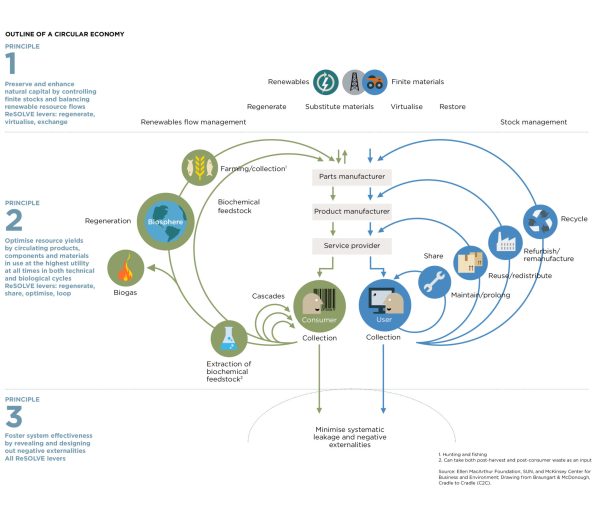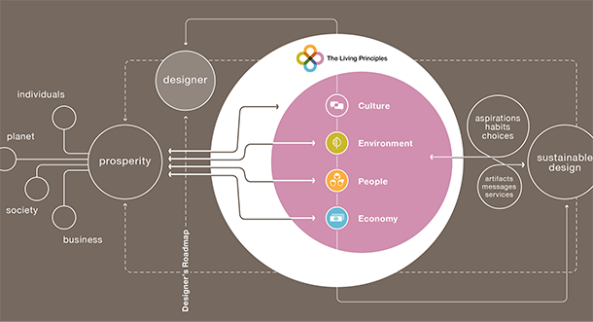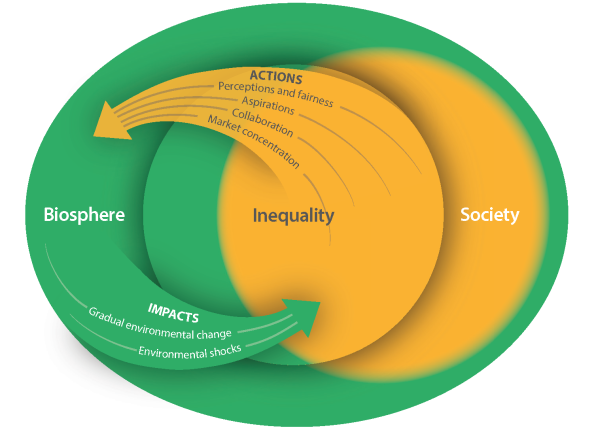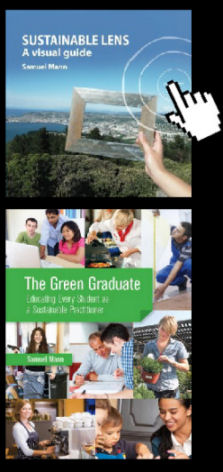It’s been 10 years since I started collecting diagrams of sustainability. Here’s some more.
283. Circles of sustainability (McCarthy and James wiki)
The Circles of Sustainability approach is explicitly critical of other domain models such as the triple bottom line that treat economics as if it is outside the social, or that treat the environment as an externality. It uses a four-domain model – economics, ecology, politics and culture. In each of these domains there are 7 subdomains.

284. Sustainable Food Systems (3 circle Venn diagram with food supply chain) (Institute of Food Science and Technology 3keel Richard Sheane)

IFST (highlighted on the figure above):
-
Resource risks and pressures: The food system is dependent on the natural environment and at the same time is causing significant environmental impacts
-
Healthy sustainable diets: There is a need to deliver good human and environmental health outcomes from the food system at the same time
-
Circular economy and sustainable manufacturing: The current economic model of “take-produce-consume-discard” is unsustainable
-
Novel production systems and ingredients: There are opportunities for developing new farming and manufacturing technologies to deliver sustainable nutrition
-
Decent work and equitable trade: The livelihoods and working conditions of the 1+ billion people who work in the food system need to be improved
-
Transparency, traceability and trust: New software and data can help drive improvements in food system sustainability and strengthen consumer trust
285. Hire wire act. (Thinkup construction)

286. Sustainable Livelihoods Framework http://www.glopp.ch/B7/en/multimedia/B7_1_pdf2.pdf
“…The framework depicts stakeholders as operating in a context of vulnerability, within which they have access to certain assets. Assets gain weight and value through the prevailing social, institutional and organizational environment (policies, institutions and processes). This context decisively shapes the livelihood strategies that are open to people in pursuit of their self-defined beneficial livelihood outcomes.” (Kollmair et al., 2002)

287. Window of viability on top of a hill. (Ellen MacArthur Foundation)

289. Strong sustainability bullseye linked to Landscape Sustainable Science (and design-in-science paradigm, Huang et al 2019).

290. Principles on a three pillar triangle (Penn State after Gagnon, see also Alkadd et al. 2016)
Those principles placed in the center of the diagram combine all three aspects of sustainability to a certain degree and hence their implementation would benefit all societal, environmental, and economic stakeholders.

291. Aidan Davidson’s atom (2008).
In my efforts to think and act through paradox in search of sustainability, the much-maligned idea of ambivalence has been of great help. Conversely, I have found unhelpful the Venn diagrams routinely used in sustainability texts to depict overlapping sets of cultural, social, economic and environmental concerns. I offer, then, with usual caveats about simplification, the metaphor of atomic structure as a potentially more interesting heuristic device.
Imagine principles of sustainability as a tightly aggregated nucleus around which orbit only loosely aggregated goals of sustainable development. The small area of agreement established by the ideal of sustainability is nonetheless sufficient to bind together a wide constellation of diverse sustainable development objectives. These objectives orbit in varying relations of proximity and stability to sustainability ideals, establishing a large field of contestation. Just as the cohering of positively charged nucleus and negatively charged electrons produces the elemental character of an atom, so too the ambivalent coupling of ideals and practices is the defining, coherent strength of the quest for sustainability. And just as the great majority of space within an atom is empty, composed not of matter but rather of potential trajectories for movement and interaction of matter, so too is the value of debate about sustainable development not to be found in fixed definitions and assertions. It is to be found in the movement and interaction of ideas and interests on retrospective questions of the future.

292. Butterfly (Ellen MacArthur Foundation) (OK, not strictly sustainability).
circular economy is regenerative and restorative by design

293. Spider diagram with explicit “transformation” dimension (Wilhelm and Wydler 2014). (After Wals and Corcoran Sustainability as an Outcome of Transformative Learning 2006).
In these spaces, three dimensions can be distinguished: a systemic, a normative and a procedural dimension (with the focus on the transformation of a system). These dimensions enable more technically-oriented sustainability assessment tools to be translated into socio-political decision-making processes.

294. Social-ecological transition and work (Bottazzi 2019)
Idealistic view of a social-ecological transition to contributive economy and contributive justice policies. Contributive economy (TB1) is based on intrinsically motivated collaboration between multiple contributors to create positive externalities. Contributive justice policies (TB2) promote a transformation of the conception of work to be considered as a value in itself and not just a mean of production. Both TB1 and TB2 principally seek to generate human capabilities as a main outcomes of socio-economic processes (TB3), leading to an improvement of workers’ autonomy, sufficiency and wellbeing (TB4). As a result, workers are able to produce their own knowledge and become more self-aware as they have more time for reflexivity, are driven by intrinsic motivations and increase their sociability and their capacity to generate social-ecological innovation. Worker’s autonomy also positively influences citizenship engagement (TB5), leading to emancipation, accountability and public engagement, supporting in return contributive justice policies (TB2). Raising awareness for social-ecological issues allows for more responsible production and consumption (TB6), supporting in return the contributive economy (TB1). TB5 and TB6 are both direct drivers of ecological resilience (TB7) that in return influence peoples’ well-being.

295. Culture is taking over the petri dish. (Duxbury 2016)

296. Somebody ate a piece of the pie. (a brainstorm around sustainable textiles)

297. Rejection of Venn, then alternative…Venn. (Tyler Caine, Intercon 2014)
The three-circled diagram strikes me more as conciliatory to the boundaries of an existing system rather than aspirational towards the creation of a new one. After all, it was the old system that has got us to this point in the first place. The tenants of sustainability should migrate beyond the green circle to frame the entirety of the system. There are degrees of balance that can encompass each circle, all of the circles and all of the circles interactions with each other so that the growth of one does not have to come to at the cost of another.

298. Neste’s “core of strategy“ (eg renewable jet fuel)

299. Flying boxes. Why? beats me. (SmileTemplates)

300. Kate Raworth’s Doughnut
Humanity’s central challenge in the 21st century is to meet the human rights of all people within the capacity of Earth’s life-support systems. In other words, we need to get into the doughnut: the safe and just sweet spot between social and planetary boundaries

301. Rodrigo’s rods and inner-tubes (https://doi.org/10.1016/j.jclepro.2008.02.008)
(existing models, Venn, Daly etc) However, they all suffer from being highly anthropocentric, compartmentalised, and lacking completeness and continuity. These drawbacks have reduced their acceptance and use by more advanced sustainability scholars, researchers and practitioners. This paper presents an innovative attempt to represent sustainability in three dimensions which show the complex and dynamic equilibria among economic, environmental and social aspects, and the short-, long- and longer-term perspectives.
302. Pillars with identity, quality and efficiency between (Kyelou and Ierapetritis 2019)

303. Living principles framework roadmap (AIGIA)
The Living Principles for Design framework is a catalyst for driving positive cultural change. It distills the four streams of sustainability—environment, people, economy and culture—into a roadmap for sustainable design that is understandable, integrated, and most importantly, actionable

304. Sustainable design ecosystem (AIGIA)

305. Anna Krachey’s Design thinking

306. We’ve had an impossible triangle before, but I couldn’t resist this architectural version.

307. Nature-based solutions (IUCN 2019)
Nature-based Solutions (NbS) are “actions to protect, sustainably manage and restore natural or modified ecosystems that address societal challenges effectively and adaptively, simultaneously providing human well-being and biodiversity benefits

308. SDGs and value creation (Integrated Reporting)

309. Venn in a triangle in a circle (The Centre for Liveable Cities Liveability Framework)

310. What’s social sustainability? I dunno either. (More than Green)

(part of animation that turns these triangles into buildings and map squares).

311. SDGs as a…
(there a lot of variations. Other than this bike, I’m including the coloured blocks or wheel of the SDGs only if it adds substance to the diagram or model).

This for example, would not make it onto the post (except as a counter example, obviously)

Although it is useful as a visual shorthand for sustainability: (Slovenian Development Strategy)

312. Whereas this use of the SDGs adds value by showing that sustainability is an holistic and a transformation (J. Lokrantz/Azote, Stockholm Resilience)

313. SDG Wedding Cake: mapping of SDGs to Strong Sustainability model (Rockström, see also Teebweb)

314. Systematic inclusive approach and equilibrium of strategic orientations (Slovenian Development Strategy)

315. Cultural Materialism: Triangle with different take on pillars (Lyngaas 2016)

316. Hero’s journey (Shari Welsh) (after Joesph Campbell’s Monomyth).

317. Structural sustainability principles as a bubbly Venn diagram (Bofylatos and Spyrou 2016)
A framework to deconstruct and frame the cognitive space associated with sustainability has been proposed in Bofylatos et al 2012. This framework was based around the notion of “structural principles of sustainability”, the six principles selected after a long bibliographical review attempted to frame the cognitive space in which sustainability will emerge. Those are: holistic, local, safe, cyclic, socially acceptable, and rational in the use of energy and materials (Bofylatos 2013) through this process we were able to visualize sustainability as the point of intersection of a Venn diagram with six objects (the principles identified). This frames the problem space in which we speculate sustainability will emerge

318. PRiSM Principles (Green Project Management)

319. Forms of Sustainable Value Creation Patterns (Carroux 2017 and Lüdeke-Freund 2108)
“A sustainable business model pattern describes an ecological, social, and/or economic problem that arises when an organisation aims to create value, and it describes the core of a solution to this problem that can be repeatedly applied in a multitude of ways, situations, contexts, and domains. An SBM pattern also describes the design principles, value-creating activities, and their arrangements that are required to provide a useful problem-solution combination.”

(like a soil texture triangle, this representation assumes a 100% sum – where increase in one aspect must have a decrease the other two).
320. I had to include this because it is so bad. Not only is it a Venn diagram, but in trying to pimp it up for display, they’ve broken it even more – sustainability is at the intersection of all three pillars, not just economic growth as this image points to (Slidegeeks)

321. Dimensions in SDGs – and a hint of origami (European Commission)

322. Hugs. Inequality as link between society and biosphere. (Hamman via Tilman)
We employed a social-ecological systems framework and identified pathways that link inequality and the biosphere. Our review finds that most research has focused only on one-directional linkages between inequality and the biosphere. We highlight examples where bi-directional and cross-scale linkages are present. Such systems call for approaches that consider the complex feedbacks and dynamics of inequality that are present at the nexus of society and the biosphere.

323. Capital interactions (Hill 2015)

324. Intergenerational sustainability. Lozano introduces time by repeating a Venn diagram.
The figure depicts the integration of the economic, environmental and social aspects, and how these keep the same weight in respect to each other from one generation to the next. Abstractly, the picture shows the stable and non-diminishing use of resources (economic, human and natural).

325. Time tube. Lozano (2008) considers a Strong Sustainability model as 1st Tier Sustainability Equilibrium (flow around a circle), which can then be stretched over time. Where the tube and the time-line diverge and the shape forms a cone is a “disequilibrium in the time dimension. Lack of long-term perspective”.

326. One Ring to rule then all. Lozano (2008)
The final step involves the interactions of both equilibria into a Two Tiered Sustainability Equilibria (TTSE). This is achieved by inter-relating the First tier sustainability equilbiria (FTSE) in dynamic change processes through time, passing from the inter-generational to the holistic perspective. In this case the FTSE may not be the same today and in the future. In the TTSE all aspects including the time perspective interrelate, or example the economic aspects of today with the economic aspects of the future, but also with the environmental aspects of the present and the future, as well as with the social aspects of the present and the future. These interactions occur with all the other aspects of the present and the long-term, which make the cylinder
suffer a metamorphosis into a doughnut shape by imploding in the direction of the time axis (Fig. 15), for this to occur time needs to bend. In the TTSE sustainability issues lie inside the doughnut and are in perennial movement inter-relating with other issues, continuously rotating in the two axes shown in the figure.


Tammy Vrana
July 24, 2019
Nice! Thank you for sharing.
Sent from my iPhone